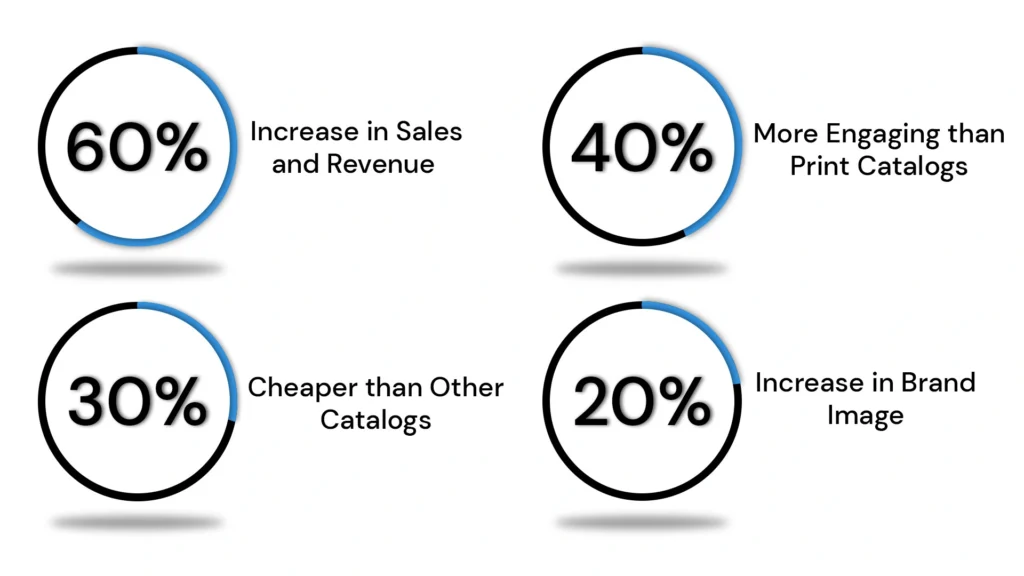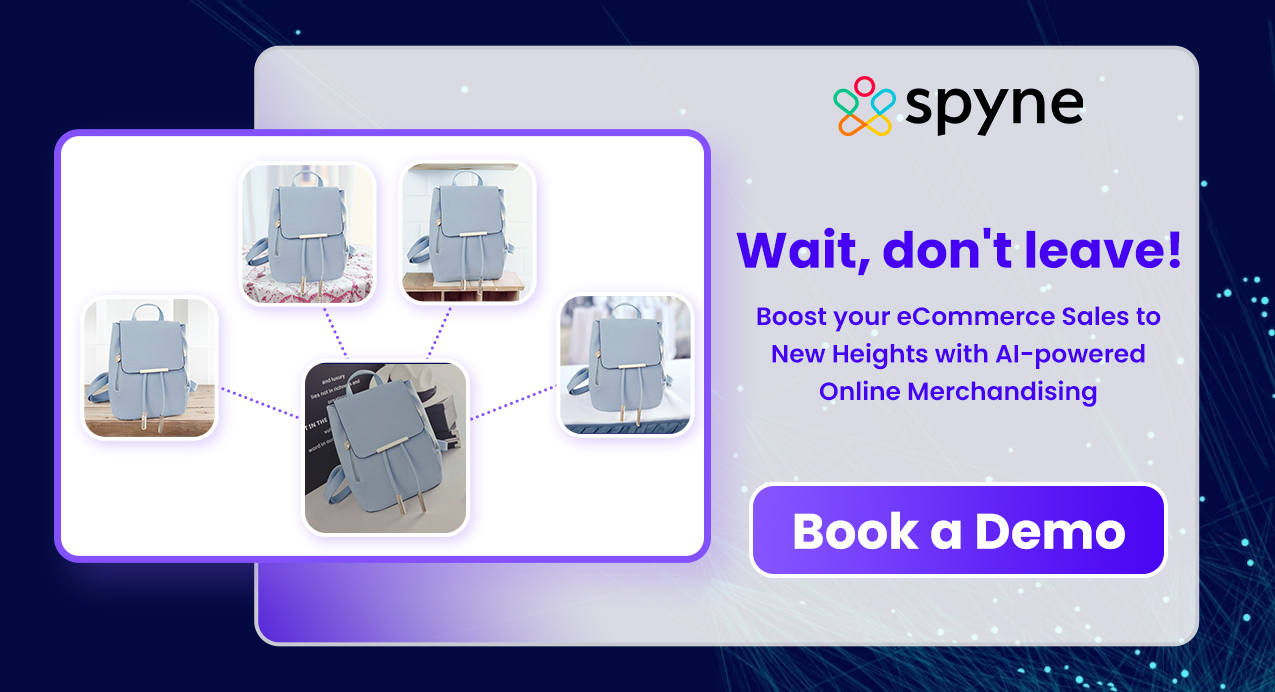Businesses constantly seek innovative ways to enhance their online presence and engage with customers. With the advancement of technology and the widespread use of the internet, digital catalogs have emerged as a powerful tool for businesses to effectively display their products, attract potential customers, and drive sales. They offer an expanded reach, an interactive experience, a cost-effective solution, and an eco-friendly approach. By leveraging digital catalogs, businesses can optimize their marketing strategies, boost sales, and stay ahead in the competitive digital landscape.
Let’s dive deeper into the world of digital catalogs and explore how they can revolutionize the way businesses showcase and sell their products.
What is a Digital Catalog?
A digital catalog is like a modern, interactive version of a traditional print catalog. It’s an online document that showcases your products and services. It serves as an interactive platform for businesses to showcase their offerings to customers in a visually appealing and engaging manner. An online product showcase, in the form of a digital catalog, allows easy access to your offerings through a direct link. This user-friendly document is a powerful tool for converting prospective customers into satisfied buyers.
A digital catalog provides customers with a seamless and immersive shopping experience, allowing them to explore products, view detailed descriptions, zoom in on images, and even purchase directly from the catalog itself. It enables businesses to showcase their entire product range or specific collections, giving customers a comprehensive overview of available options.
Functionally, digital catalogs often incorporate interactive features such as clickable links, videos, product animations, and search functionalities, making it easier for customers to navigate and find the products they are interested in. Moreover, they can be designed with intuitive user interfaces and responsive layouts, ensuring optimal viewing across various devices and screen sizes.
Different types of digital catalogs depend on the industry and specific requirements. Some include:
- Fashion and Apparel Catalogs: Showcasing clothing, accessories, and fashion collections.
- Home and Furniture Catalogs: Displaying furniture, home decor, and interior design options.
- Electronics and Gadgets Catalogs: Featuring the latest tech gadgets, electronics, and appliances.
- Automotive Parts Catalogs: Providing a comprehensive car parts and accessories overview.
- Wholesale Product Catalogs: Catering to business-to-business (B2B) customers and showcasing bulk product offerings.

How To Create Interactive Online Catalogs?
To create interactive online catalogs you need to follow these simple steps:
1) Upload the file into the online catalog maker. No matter the size of your file, the creator will easily turn it into an online catalog.
2) You can also customize your digital catalog. You can set up your design and add custom backgrounds.
3) Make your online catalog interactive with attractive features for successful sales.
4) Share your digital product catalog directly with your target audience through a link or embed it on your website for easy access on any page.
Different Types of Catalog
A catalog is a type of marketing collateral that lists essential details that help buyers make an informed decision. Catalogs come in various types tailored to specific industries and purposes, Here are the top 10 types of catalogs, including:
1) Fashion Catalog: Showcases clothing and accessories, featuring images and details to entice customers.
2) Service Catalog: Lists and describes the range of services offered by a business, often detailing service packages and pricing.
3) Product Catalog: Displays a company’s products with relevant information such as prices, specifications, and images.
4) Furniture Catalog: Highlights a collection of furniture items, providing details on design, materials, and dimensions.
5) Business Catalog: Offers an overview of a company’s offerings, including services, products, and key information about the business.
6) Clothing Catalog: Similar to a fashion catalog, this specifically focuses on clothing items, styles, and trends.
7) Food Catalog: Features a selection of food products, menus, or recipes, often used by restaurants, grocers, or food manufacturers.
8) Hotel Catalog: Presents information about a hotel’s rooms, amenities, services, and special offerings to attract guests.
9) Sports Catalog: Showcases sports-related products such as equipment, apparel, and accessories.
10) Office Catalog: Displays office supplies, furniture, and equipment for businesses and organizations to streamline procurement.
Each type of catalog serves a specific purpose, aiding businesses in presenting their offerings effectively to their target audience.
Top Features of Product Catalogs
Product Catalogs enhance the overall appeal and efficiency of the product. Product catalogs have a variety of features. Let’s explore the top 10 features of the product catalogs:
1) Brand Awareness
Product catalogs contribute to building brand awareness by presenting a consistent visual identity, and messaging, and showcasing the brand’s unique offerings.
2) Decreased Cost
Digital and well-designed print catalogs can significantly reduce production, printing, and distribution costs compared to traditional methods.
3) Enhanced Accessibility
Catalogs, whether in print or digital format, provide easy access for customers to explore and learn about products, enhancing overall accessibility.
4) Interactivity
Digital catalogs offer interactive elements, such as clickable links and multimedia content, engaging customers in a more dynamic and immersive shopping experience.
5) Saves Cost and Time
The digital format allows for easy updates and modifications, eliminating the need for costly and time-consuming reprints associated with traditional catalogs.
6) Analytics and Insights
Digital catalogs enable the collection of valuable data on customer interactions, providing insights that can inform marketing strategies and decision-making.
7) Responsive Web Design
Digital catalogs can be designed with responsive layouts, ensuring optimal viewing experiences across various devices, including desktops, tablets, and smartphones.
8) Personalization
Catalogs can be personalized to cater to individual customer preferences, presenting relevant products and content based on user behavior and demographics.
9) Product Description
Comprehensive product descriptions within catalogs provide customers with essential details, helping them make informed purchasing decisions.
10) Showcase Product Range
Catalogs effectively showcase a diverse range of products, organized in a visually appealing manner to give customers a comprehensive overview of the available offerings.
What are The Benefits of Creating a Digital Catalog?
There are many benefits of creating a digital catalog. Here we have listed the top 10 benefits of creating a digital catalog:
1) Convenience and Accessibility: Enjoy the ease of access and convenience as your digital catalogue maker is readily available for customers online, enhancing their shopping experience.
2) Easily Shareable Online: Share your catalog smoothly and widely by sharing it with ease on various web platforms.
3) Easy to Update and Maintain: You can easily update and maintain your catalog to keep your product information up to-date and relevant.
4) Cost Reduction in Administration, Printing, and Distribution: Using an online catalog creator offers a more cost-effective way to reduce administrative work, printing costs, and distribution prices.
5) Another Level of Professionalism: Elevate your business’s professional image by presenting your products in a polished and modern digital catalog.
6) Integration with eCommerce and ERP: Streamline and boost overall efficiency by seamlessly integrating your free digital catalog marker with ERP and eCommerce platforms.
7) Collection of Key Customer Data: By utilizing your digital catalog, you can collect crucial customer information that will help you better understand your customers and adjust your products.
8) Easily Scalable Catalogs: Easily expand or contract your catalogs to meet evolving business requirements or an expanding product line.
9) Fast and Smart Product Search: Provide customers with a quick and intelligent product search experience within your digital catalog, enhancing their ability to find desired items efficiently.
10) Competitive Advantage: Gain a competitive edge by utilizing a digital catalog, staying ahead of competitors, and meeting the expectations of modern consumers.
What is a Digital Product Catalog for e-commerce?
A digital product catalog for eCommerce photography is an online document that showcases your products or services, can be accessed as a direct link, and is easy to navigate. It is a comprehensive and interactive showcase of products that customers can browse, explore, and purchase directly from an eCommerce platform.
Unlike physical product catalogs, a digital product catalog for eCommerce is accessed through a website or mobile application. It provides customers with a seamless and user-friendly interface to discover and explore the company’s offerings. The catalog typically includes product images, descriptions, pricing information, and other relevant details to facilitate informed purchasing decisions.

The key features and benefits of a digital product catalog for eCommerce include:
1. Vast Product Range
Digital catalogs allow businesses to showcase their entire product range easily and interactively online, thus guaranteeing that customers have access to a wide variety of choices within a single platform.
2. Dynamic Updates
You can easily update and modify them to reflect changes in your inventory, pricing, or product details. Thus, you can ensure that customers constantly have access to the latest information.
3. Interactive Experience
Digital catalogs offer interactive features such as zooming, product image galleries, and customer reviews, enhancing the browsing experience and allowing customers to make more informed decisions.
4. Search and Filter Capabilities
Digital product catalogs often include search functionalities and filtering options, allowing customers to quickly find specific products based on their preferences, such as size, color, or price range.
5. Seamless Integration with eCommerce Platforms
Digital catalogs are seamlessly integrated, enabling customers to add products to their shopping carts, proceed to checkout, and complete their purchases without leaving the catalog interface.
6. Cross-Selling and Upselling Opportunities
Digital product catalogs allow businesses to showcase related or complementary products, encouraging cross-selling and upselling to increase the average order value.
7. Analytics and Insights
Through analytics tools, businesses can gather valuable data on customer behavior within the digital catalog, such as popular products, click-through rates, and conversion rates. These insights can inform marketing strategies, inventory management, and overall business decisions.
Digital Catalog vs. Paper Catalog: Pros and Cons
Digital and paper catalogs are different mediums for showcasing products or services to customers. Each choice comes with its own pros and cons. Let’s find out what they offer:
Pros of Digital Catalog
Cost-Effective: Creating and distributing catalogs is generally more cost-effective than printing and distributing paper catalogs. They eliminate printing and shipping expenses.
Accessibility and Reach: They can be accessed anytime, anywhere, as long as an internet connection exists. They have a wider reach and can be easily shared through email, social media, and websites, reaching a larger audience.
Interactivity: They offer interactive features such as zooming, 360-degree views, videos, and links. These elements enhance customer engagement, allowing them to explore products in detail and make informed purchasing decisions.
Real-Time Updates: Digital catalogs can be updated in real-time to reflect changes in inventory, pricing, or product details. This ensures that customers always have the most up-to-date information, reducing the risk of displaying outdated or unavailable products.
Cons of Digital Catalog
Technology Dependency: Catalogs require electronic devices and an internet connection to access. This reliance on technology may limit accessibility for customers with limited internet access or who prefer physical catalogs, affecting your brand reach significantly in some geographies.
Digital Overload: In a digital world filled with advertisements and content, customers may be overwhelmed by the sheer volume of digital information. This can make it challenging for digital catalogs to stand out and capture customers’ attention.
Pros of Paper Catalogs
Tangible Experience: Paper catalogs provide a tactile experience, allowing customers to flip through the pages and engage with the content physically.
Offline Accessibility: Paper catalogs do not require an internet connection, making them accessible anytime, anywhere. Thus, they can be easily carried, browsed, and shared without electronic devices.
Targeted Audience: Paper catalogs can target a particular demographic or niche audience. This allows businesses to tailor the content and design to cater to the preferences of their target market.
Cons of Paper Catalog
Printing and Distribution Costs: Creating and printing paper catalogs can be expensive, especially for businesses with a wide range of products. Additionally, the costs of distributing paper catalogs through mail or physical locations can increase.
Limited Updates: Once a paper catalog is printed, any changes or updates to products or pricing require reprinting and redistributing. This makes providing customers with real-time information challenging and can lead to discrepancies between the catalog and actual inventory.
Environmental Impact: Above all, the demand for paper contributes to deforestation and generates significant waste. In an era where sustainability is increasingly important, the environmental impact of paper catalogs is a consideration.
Reasons Why Businesses Need a Digital Catalog Creator
It has become essential for businesses to adapt the changing consumer behaviors and preferences. A digital catalog maker is a valuable tool to help businesses meet these evolving demands.

Here are five reasons businesses need a digital catalog creator:
1. Provides a New Kind of Shopping Experience
A digital catalog maker allows businesses to offer their customers a unique and immersive shopping experience. By leveraging interactive elements such as zoomable images, 360-degree product views, and embedded videos, businesses can engage customers in a visually compelling way. This novel shopping experience enhances customer satisfaction and increases the likelihood of purchasing.
2. Keeps Up with Changed Retail Expectations
Consumer expectations have shifted in the digital age. Nowadays, shoppers expect businesses to provide seamless online experiences that match or exceed the convenience of traditional brick-and-mortar stores. Catalog creator enables businesses to meet these expectations by providing an intuitive and user-friendly interface that showcases products effectively. It helps companies to stay competitive and relevant in the rapidly evolving retail landscape.
3. Boosts Sales Directly through a Digital Catalog
Digital catalogs offer the advantage of direct sales functionality. With a digital catalog creator, businesses can integrate e-commerce capabilities, thus allowing customers to purchase directly, streamlining the process. This streamlined shopping process eliminates customers’ need to navigate multiple web pages or platforms, leading to higher conversion rates and increased sales.
4. Offers an Unforgettable Shopping Experience
A digital catalog creator allows businesses to create visually stunning and memorable catalogs. Businesses can leave a lasting impression on customers using engaging visuals, compelling product descriptions, and interactive features. This memorable shopping experience drives immediate sales, fosters brand loyalty, and encourages repeat purchases in the long term.
5. Encourages Product Discovery
Digital catalogs allow businesses to showcase their entire product range effectively. You can organize and present products intuitively through a digital catalog maker, and as a result, customers can discover new offerings and explore complementary items. By encouraging product discovery, businesses can increase average order value and cross-selling opportunities, ultimately boosting sales.

Digital Catalog Examples
There are plenty of examples of digital product catalogs. Here are a few notable ones, categorized by their strengths:
1) Foleon Service Catalog: This is a great example of using interactive elements and storytelling to make a service catalog engaging and informative.
2) Volvo Automobile Catalog: This catalog utilizes 360° views and immersive experiences to showcase the features and technology of their vehicles.
3) Nestle Cuisine Catalog: This catalog cleverly combines recipes with product information, making it a valuable resource for home cooks.
4) Forbo Interior Design Catalog: This catalog highlights the versatility of their flooring products through beautiful design projects and room simulations.
5) Tupperware Catalog: This catalog excels at striking a balance between beautiful visuals, informative content, and user-friendly design.
6) Fleggard Supermarket Catalog: This catalog is a practical example of a mobile-optimized grocery catalog, making it easy for customers to plan their shopping trips.
7) BoConcept Furniture Catalog: This catalog utilizes sleek design and high-quality photography to create a desirable aspirational experience for customers.
8) Sinnerup Retail & Decoration Catalog: This catalog features a curated selection of unique products with detailed descriptions and inspiration for their use.
9) Sorli Supermarket Catalog: This catalog focuses on local sourcing and sustainability, catering to a growing customer preference for conscious consumption.
10) Nike Catalog: Their catalog employs a recommendation engine that suggests additional products based on the user’s current selection
11) IKEA Catalog: Their interactive catalog utilizes stunning 360° room views and drag-and-drop furniture placement, allowing customers to visualize how IKEA products look in their own homes.
12) Lululemon Catalog: Their catalog features high-quality, lifestyle-oriented product photography showcasing models using the products in action.
Digital Catalog Templates
Effortlessly enhance the visual representation of your products and services using captivating catalog templates. These templates are thoughtfully designed with creative layouts, providing you with ample opportunities for seamless customization. With the flexibility to replace content and images with your own, you can easily tailor each template to meet your unique preferences. Download your personalized catalog easily, and ensure that your offerings are presented in a visually stunning and impactful manner to leave a lasting impression on your audience.
How to Use Digital Catalogs to Grow Sales?
The dynamic nature of digital platforms allows for a myriad of innovative approaches. Whether you’re utilizing a free online catalog creator, exploring digital catalog software, or opting for a digital catalog-free solution, the possibilities are vast. Learn how to drive traffic, optimize conversion rates, and ultimately propel your sales to new heights using the latest tools and techniques in the digital catalog realm.
Let’s explore the key features of the digital catalogs to grow sales in detail:
1) Use interactive elements: Use 360° views, and other interactive elements to drive sales.
2) Mobile-first approach: Ensure your catalog looks and functions flawlessly on smartphones and tablets.
3) Stay Updated: Update pricing, inventory, and product information in real-time.
4) Ensure fast load times: Optimize and ensure fast load time
5) Drive traffic: Optimize your catalog for relevant keywords to drive organic traffic.
6) Utilize Retargeting: Leverage retargeting ads to remind browsing customers about potential purchases.
7) Drive traffic directly with email: Include links to your digital catalog in email campaigns and newsletters.
8) Utilize social media: Use social media platforms to showcase exciting products and engaging catalog features.
9) Use web push notifications: Use targeted web push notifications to entice customers with relevant deals and promotions.
10) Conversion Rate Optimisation (CRO): Analyze user behavior and optimize your catalog for better conversion rates.
11) Use Analytics Tools: Use analytics tools to understand user interactions and preferences
12) Utilize digital catalog in sales pitches: Use the digital catalog during sales pitches for presentations and product demonstrations.
The Best Digital Catalog Maker – Spyne
When choosing a reliable and feature-rich digital catalog maker, Spyne stands out as an exceptional solution. It offers comprehensive tools and features that empower businesses to create stunning and practical digital catalogs and improve sales performance as a result.
Here’s why it is regarded as one of the best digital catalog makers in the market:
1. User-Friendly Interface
Its intuitive interface makes it easy for businesses to create professional-looking digital product catalogs without requiring extensive design or technical skills. The platform offers a drag-and-drop editor, pre-designed templates, and customizable layouts, enabling businesses to create catalogs that align with their brand identity effortlessly.
2. Versatile and Interactive Features
It provides a range of interactive features that enhance the browsing experience for customers. Businesses can incorporate zoomable product images, 360-degree views, product videos, and clickable links within their digital catalogs. These interactive elements engage customers, allowing them to explore products in detail and make informed purchasing decisions.
3. Seamless E-commerce Integration
It integrate with e-commerce platforms, allowing businesses to integrate digital catalogs with their online stores. This integration lets customers add products to their shopping carts and complete purchases without leaving the catalog interface. The streamlined purchasing process increases conversion rates and drives sales.
4. Customizable Branding
Using AI photo editor, businesses can customize their digital product catalogs to reflect their brand identity. The platform offers branding options such as logo placement, color customization, and background selection. This ensures businesses maintain a consistent brand experience throughout their digital catalogs, reinforcing brand recognition and customer trust.
5. Responsive Design
Digital catalogs are designed to be responsive, ensuring optimal viewing experiences across various devices and screen sizes. The AI system automatically edits your images as per the guidelines specified by different eCommerce platforms. All you need to do it choose a platform, and voila! The system will optimize your product pictures accordingly, thus ensuring easy listings for your business!
6. Excellent Customer Support
It offers reliable customer support to assist businesses at every step of the catalog creation process. Whether it’s troubleshooting technical issues or providing guidance on catalog design, our customer support team is readily available to address any queries or concerns.
Conclusion
A digital product catalog has become essential for businesses looking to thrive in the competitive e-commerce industry. To meet the demands of the digital age, businesses need a reliable and feature-rich digital catalog creator. Digital catalogs redefine sales dynamics, and platforms like Spyne simplify the process. With user-friendly features and impactful elements, businesses can effortlessly create visually appealing catalogs. It makes it easy to drive traffic, engage customers, and boost sales. Embracing digital catalogs through AI platform ensures a competitive edge in this innovation-driven era, creating a seamless and immersive experience for customers that fosters brand loyalty and sustainable growth.

















